Middleton W.M. (ed.) Reference Data for Engineers: Radio, Electronics, Computer and Communications
Подождите немного. Документ загружается.

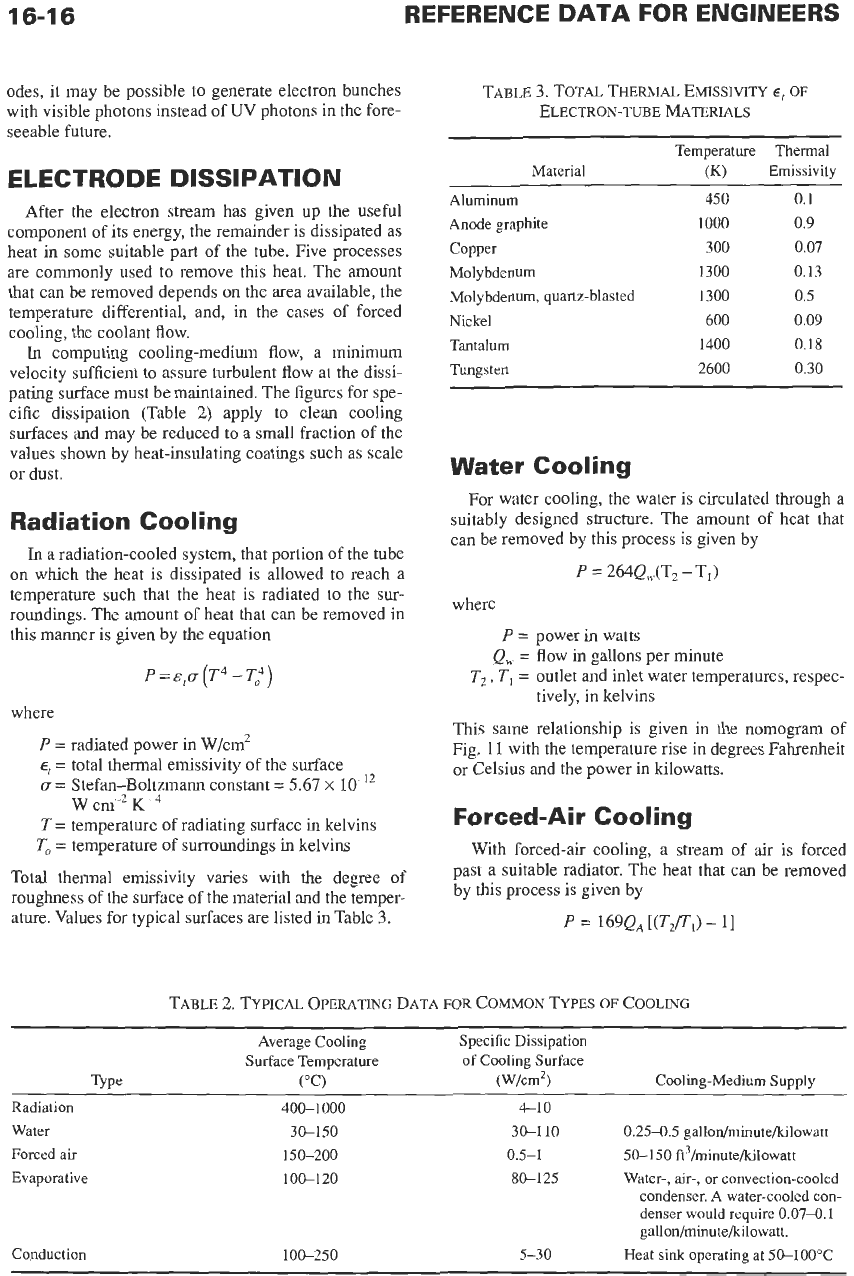
16-1
6
REFERENCE DATA
FOR
ENGINEERS
odes, it may be possible to generate electron bunches
with visible photons instead of
UV
photons in the fore-
seeable future.
ELECTRODE DISSIPATION
After the electron stream has given up the useful
component of its energy, the remainder is dissipated as
heat in some suitable part of the tube. Five processes
are commonly used to remove this heat. The amount
that can be removed depends
on
the area available, the
temperature differential, and, in the cases of forced
cooling, the coolant flow.
In
computing cooling-medium flow,
a
minimum
velocity sufficient to assure turbulent flow at the dissi-
pating surface must be maintained. The figures for spe-
cific dissipation (Table
2)
apply to clean cooling
surfaces and may be reduced to
a
small fraction of the
values shown by heat-insulating coatings such
as
scale
or dust.
Radiation Cooling
In
a
radiation-cooled system, that portion of the tube
on
which the heat is dissipated is allowed to reach a
temperature such that the heat is radiated
to
the
sur-
roundings. The amount of heat that can be removed in
this manner is given by the equation
P
=
Et(T
(T4
-
T,4)
where
P
=
radiated power in W/cm2
et
=
total thermal emissivity
of
the surface
IT=
Stefan-Boltzmann constant
=
5.67
x
T
=
temperature of radiating surface in kelvins
To
=
temperature of surroundings in kelvins
Total thermal emissivity varies with the degree of
roughness of the surface of the material and the temper-
ature. Values for typical surfaces are listed in Table
3.
W cm-'
K
TABLE
3.
TOTAL THERMAL EMISSIVITY
E,
OF
ELECTRON-TUBE MATERIALS
Temperature Thermal
Material
(K)
Emissivity
Aluminum
Anode graphite
Copper
Molybdenum
Molybdenum, quartz-blasted
Nickel
Tantalum
Tungsten
450
1000
300
1300
1300
600
1400
2600
0.1
0.9
0.07
0.13
0.5
0.09
0.18
0.30
Water
Cooling
For water cooling, the water is circulated through a
suitably designed structure. The amount of heat that
can be removed by this process is given by
P
=
264QW(T2 -TI)
where
P
=
power
in
watts
Q,
=
flow in gallons per minute
T2,
T,
=
outlet and inlet water temperatures, respec-
This same relationship is given in the nomogram
of
Fig.
11
with the temperature rise in degrees Fahrenheit
or Celsius and the power
in
kilowatts.
tively, in kelvins
Forced-Air Cooling
With forced-air cooling,
a
stream of air is forced
past a suitable radiator. The heat that can be removed
by this process is given by
P
=
169QA
[(T,/T,)
-
11
TABLE 2. TYPICAL OPERATING DATA
FOR
COMMON
TYPES
OF
COOLING
Average Cooling Specific Dissipation
Surface Temperature
of
Cooling Surface
Type ("C) (W/cm2) Cooling-Medium Supply
Radiation
400-1000 4-1
0
Water
Forced air
Evaporative
Conduction
30-150
150-200
100-120
100-250
30-1 10 0.2545
gallon/minute/lulowatt
0.5-1
50-150
ft3/minute/kilowatt
80-125
Water-,
air-,
or convection-cooled
condenser.
A
water-cooled con-
denser would require
0.07-0.1
gallon/minute/kilowatt.
Heat sink operating at
50-100°C
5-30
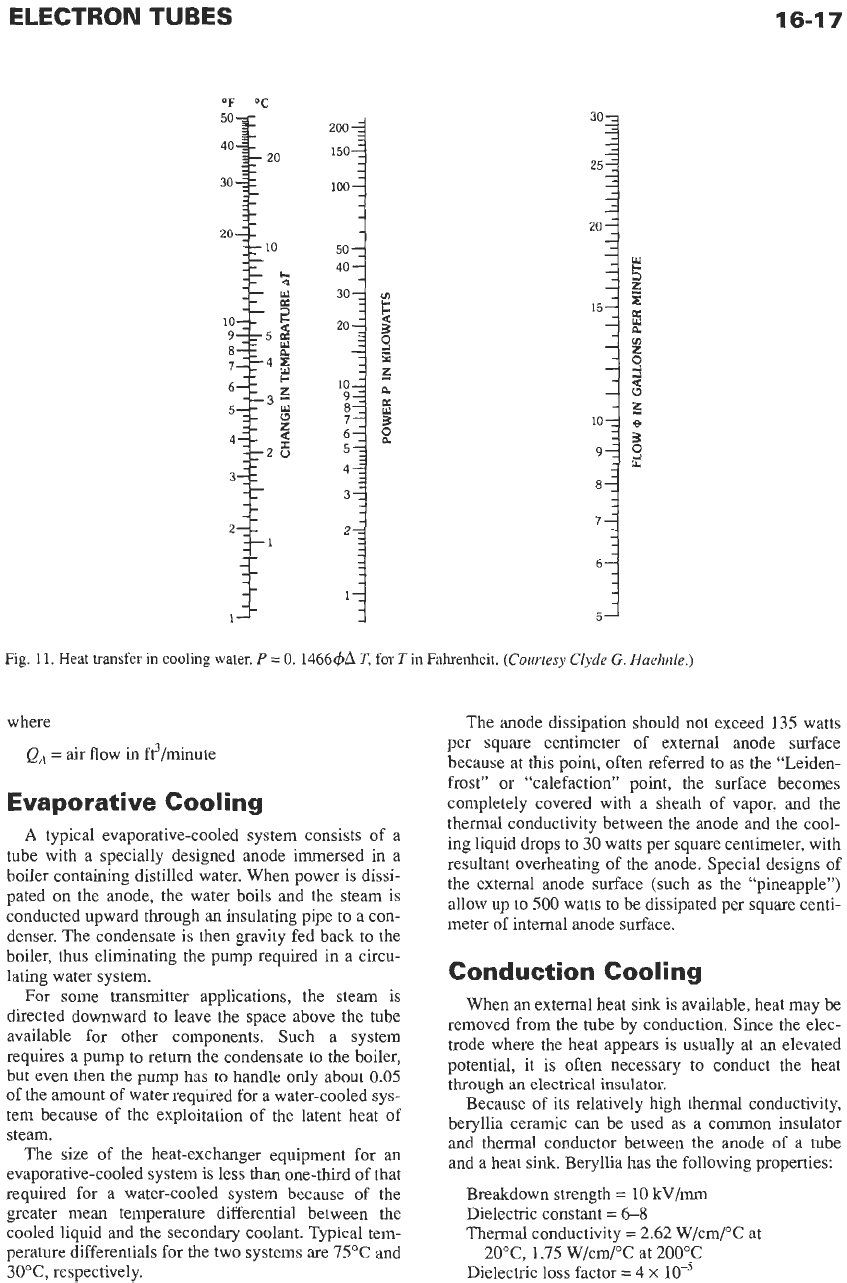
ELECTRON
TUBES
7
6-1
7
Fig.
11.
Heat transfer in cooling water.
P
=
0.
1466@
T,
for
Tin
Fahrenheit.
(Courtesy
Clyde
G.
Huehnle.)
where
=
air
AOW
in
ft3/minute
Evaporative Cooling
A
typical evaporative-cooled system consists of a
tube with a specially designed anode immersed in a
boiler containing distilled water. When power is dissi-
pated
on
the anode,
the
water boils and the steam is
conducted upward through
an
insulating pipe to a con-
denser. The condensate is then gravity fed back to the
boiler,
thus
eliminating the pump required
in
a circu-
lating water system.
For
some transmitter applications, the steam is
directed downward to leave the space above the tube
available for other components. Such a system
requires a pump to return the condensate to the boiler,
but even then the pump has to handle
only
about
0.05
of the amount of water required for a water-cooled sys-
tem because of the exploitation of the latent heat of
steam.
The size of the heat-exchanger equipment for
an
evaporative-cooled system is less than one-third of that
required for a water-cooled system because of the
greater mean temperature differential between the
cooled liquid and the secondary coolant. Typical tem-
perature differentials for the two systems are 75OC and
30°C,
respectively.
The anode dissipation should not exceed 135 watts
per square centimeter of external anode surface
because at this point, often referred to as the “Leiden-
frost” or “calefaction” point, the surface becomes
completely covered with a sheath of vapor, and the
thermal conductivity between the anode and the cool-
ing liquid drops to
30
watts per square centimeter, with
resultant overheating of the anode. Special designs of
the external anode surface (such as the “pineapple”)
allow
up
to
500
watts to be dissipated per square centi-
meter of internal anode surface.
Conduction Cooling
When an external heat sink is available, heat may be
removed from the tube by conduction. Since the elec-
trode where the heat appears is usually at
an
elevated
potential, it
is
often necessary to conduct the heat
through an electrical insulator.
Because of
its
relatively high thermal conductivity,
beryllia ceramic can be used as a common insulator
and thermal conductor between the anode of a tube
and a heat sink. Beryllia has the following properties:
Breakdown strength
=
10
kV/mm
Dielectric constant
=
6-8
Thermal conductivity
=
2.62
W/cm/”C at
Dielectric loss factor
=
4
X
lo-’
20°C, 1.75 W/cm/”C at
200°C
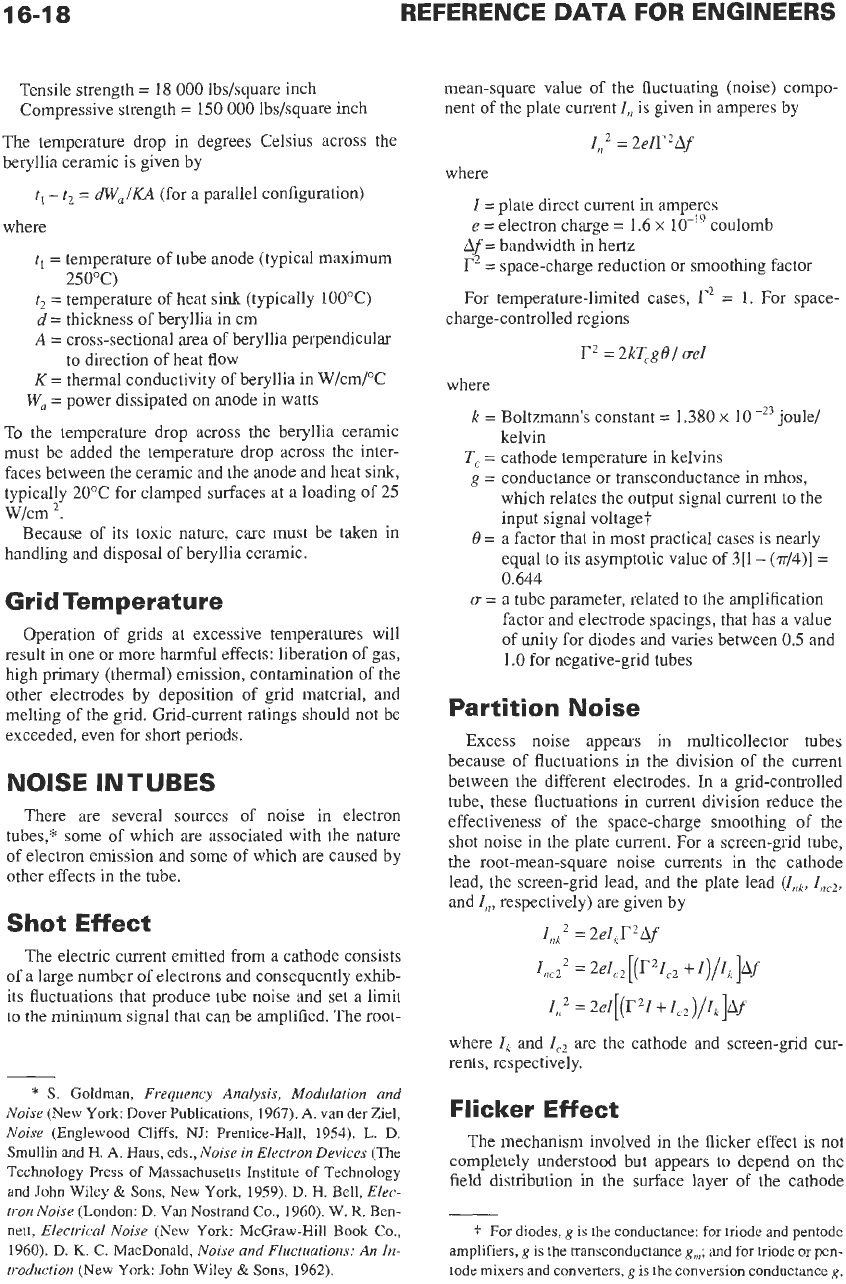
16-1
8
REFERENCE
DATA
FOR ENGINEERS
Tensile strength
=
18
000
lbs/square inch
Compressive strength
=
150
000
Ibs/square inch
The temperature drop in degrees Celsius across the
beryllia ceramic is given by
t,
-
tz
=
dw,
IKA
(for a parallel configuration)
where
t,
=
temperature of tube anode (typical maximum
t2
=
temperature of heat
sink
(typically 100°C)
d
=
thickness of beryllia in cm
A
=
cross-sectional area of beryllia perpendicular
to direction of heat flow
K
=
thermal conductivity of beryllia in W/cm/”C
250°C)
Wo
=
power dissipated on anode in watts
To
the temperature drop across the beryllia ceramic
must be added the temperature drop across the inter-
faces between the ceramic and the anode and heat sink,
typically 20°C for clamped surfaces at a loading of 25
W/cm
’.
Because of its toxic nature, care must be taken in
handling and disposal of beryllia ceramic.
Grid Temperature
Operation of grids at excessive temperatures will
result in one or more harmful effects: liberation of gas,
high primary (thermal) emission, contamination of the
other electrodes by deposition of grid material, and
melting of the grid. Grid-current ratings should not be
exceeded, even for short periods.
NOISE INTUBES
There
are
several sources of noise in electron
tubes,” some of which are associated with the nature
of
electron emission and some of which are caused by
other effects in the tube.
Shot Effect
The electric current emitted from a cathode consists
of
a large number of electrons and consequently exhib-
its fluctuations that produce tube noise and set
a
limit
to
the
minimum
signal
that can
be
amplified. The root-
*
S. Goldman,
Frequency Analysis, Modulation and
Noise
(New York: Dover Publications, 1967).
A.
van der Ziel,
Noise
(Englewood Cliffs, NJ: Prentice-Hall, 1954).
L.
D.
Smullin and
H.
A.
Haus, eds.,
Noise in Electron Devices
(The
Technology
Press
of
Massachusetts Institute of Technology
and John Wiley
&
Sons,
New York, 1959). D.
H.
Bell,
Elec-
tron Noise
(London: D. Van Nostrand
Co.,
1960).
W.
R.
Ben-
nett,
Electrical Noise
(New
York: McGraw-Hill
Book
Co.,
1960).
D.
K.
C.
MacDonald,
Noise and Fluctuations: An In-
troduction
(New York: John
Wiley
&
Sons, 1962).
mean-square value
of
the fluctuating (noise) compo-
nent of the plate current
I,
is given in amperes by
zn2
=
2eK2Af
where
I
=
plate direct current in amperes
e
=
electron charge
=
1.6
x
coulomb
Af
=
bandwidth in hertz
r2
=
space-charge reduction
or
smoothing factor
For temperature-limited cases,
r2
=
1.
For space-
charge-controlled regions
F2
=2kT,gB/uel
where
k
=
Boltzmann’s constant
=
1.380
x
10
-23
joule/
kelvin
T,
=
cathode temperature in kelvins
g
=
conductance or transconductance in
mhos,
which relates the output signal current
to
the
input signal voltage?
0
=
a factor that in most practical cases is nearly
equal
to
its asymptotic value of 3[1-
(~/4)]
=
0.644
u
=
a tube parameter, related to the amplification
factor and electrode spacings, that has a value
of unity for diodes and varies between
0.5
and
1.0
for negative-grid tubes
Partition Noise
Excess noise appears in multicollector tubes
because of fluctuations in the division of the current
between the different electrodes.
In
a grid-controlled
tube, these fluctuations in current division reduce the
effectiveness of the space-charge smoothing
of
the
shot noise in the plate current. For a screen-grid tube,
the root-mean-square noise currents in the cathode
lead, the screen-grid lead, and the plate lead
(Ink,
Zncz,
and
In,
respectively) are given by
I,,k2
=
2eIkr2Af
Id2
=
2eIc2
[(%
+
I)/Ik]Af
1,’
=
2el[(I?’Z+Z,.,)/Zk]Aj
where
1,
and
Ic2
are the cathode and screen-grid cur-
rents, respectively.
Flicker Effect
The mechanism involved in the flicker effect is not
completely understood but appears to depend on the
field distribution in
the
surface layer
of
the cathode
+
For
diodes,
g
is the conductance: for triode and pentode
amplifiers,
g
is the transconductance
gnz;
and
for
triode
or
pen-
tode mixers and converters,
g
is the conversion conductance
g.
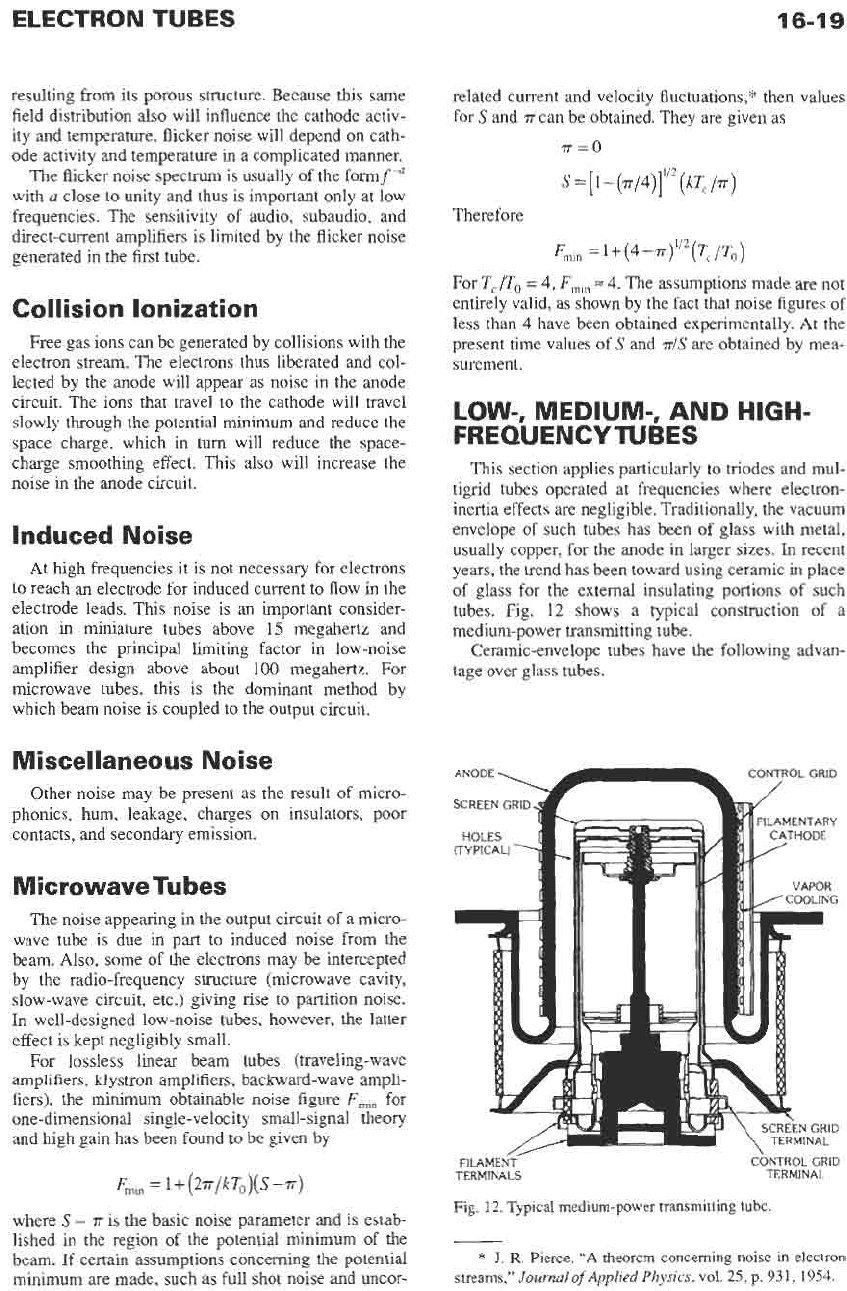
ELECTRON TUBES
16-1
9
resulting from its porous structure. Because this same
field distribution also will influence the cathode activ-
ity and temperature, flicker noise will depend on cath-
ode activity and temperature
in
a complicated manner.
The flicker noise spectrum is usually of the formf-“
with
a
close to unity and thus is important only at low
frequencies. The sensitivity of audio, subaudio, and
direct-current amplifiers is limited by the flicker noise
generated in the first tube.
Collision Ionization
Free gas ions can be generated by collisions with the
electron stream. The electrons thus liberated and col-
lected by the anode will appear as noise in the anode
circuit. The ions that travel to the cathode will travel
slowly through the potential minimum and reduce the
space charge, which in turn will reduce the space-
charge smoothing effect. This also will increase the
noise in the anode circuit.
Induced Noise
At high frequencies it is not necessary for electrons
to reach an electrode for induced current to flow in the
electrode leads. This noise is an important consider-
ation in miniature tubes above
15
megahertz and
becomes the principal limiting factor in low-noise
amplifier design above about
100
megahertz. For
microwave tubes, this is the dominant method by
which beam noise is coupled to the output circuit.
Miscellaneous Noise
Other noise may be present as the result of micro-
phonics, hum, leakage, charges on insulators, poor
contacts, and secondary emission.
Microwave Tubes
The noise appearing
in
the output circuit of a micro-
wave tube is due in part to induced noise from the
beam.
Also,
some of the electrons may be intercepted
by the radio-frequency structure (microwave cavity,
slow-wave circuit, etc.) giving rise to partition noise.
In well-designed low-noise tubes, however, the latter
effect
is
kept negligibly small.
For lossless linear beam tubes (traveling-wave
amplifiers,
klystron
amplifiers, backward-wave ampli-
fiers), the minimum obtainable noise figure
Fmin
for
one-dimensional single-velocity small-signal theory
and high gain has been found
to
be given by
F,,
=
1+(277/kT0)(S-7T)
where
S
-
7r
is the basic noise parameter and is estab-
lished
in
the region
of
the potential minimum of the
beam.
If
certain assumptions concerning the potential
minimum
are
made, such
as
full shot noise and uncor-
related current and velocity fluctuations,” then values
for
S
and
n-
can be obtained. They are given
as
77=0
s
=
[
1
-
(7~/4)]”’
(k~,
/T)
Therefore
Fmin
=~+(~-T)~’~(T,/T~)
For
T,/TO
=
4,
Fmin
=
4.
The assumptions made are not
entirely valid, as shown by the fact that noise figures of
less than
4
have been obtained experimentally. At the
present time values
of
S
and
?r/S
are obtained by mea-
surement.
LOW-,
MEDIUM-, AND
HIGH-
FREQUENCYTUBES
This section applies particularly to triodes and mul-
tigrid tubes operated at frequencies where electron-
inertia effects are negligible. Traditionally,
the
vacuum
envelope of such tubes has been of glass with metal,
usually copper, for the anode in larger sizes. In recent
years, the trend has been toward using ceramic in place
of glass for the external insulating portions of such
tubes. Fig.
12
shows
a
typical construction of a
medium-power transmitting tube.
Ceramic-envelope tubes have the following advan-
tage over glass tubes.
ILAMENTARY
FILAMENT
//
TERMINALS
GRID
NAL
C~NTROL
GRID
TERMINAL
Fig.
12.
Typical medium-power transmitting tube.
*
J.
R.
Pierce,
“A
theorem concerning noise
in
electron
streams,”
Journal
of
Applied
Physics,
vol.
25,
p.
931,
1954.
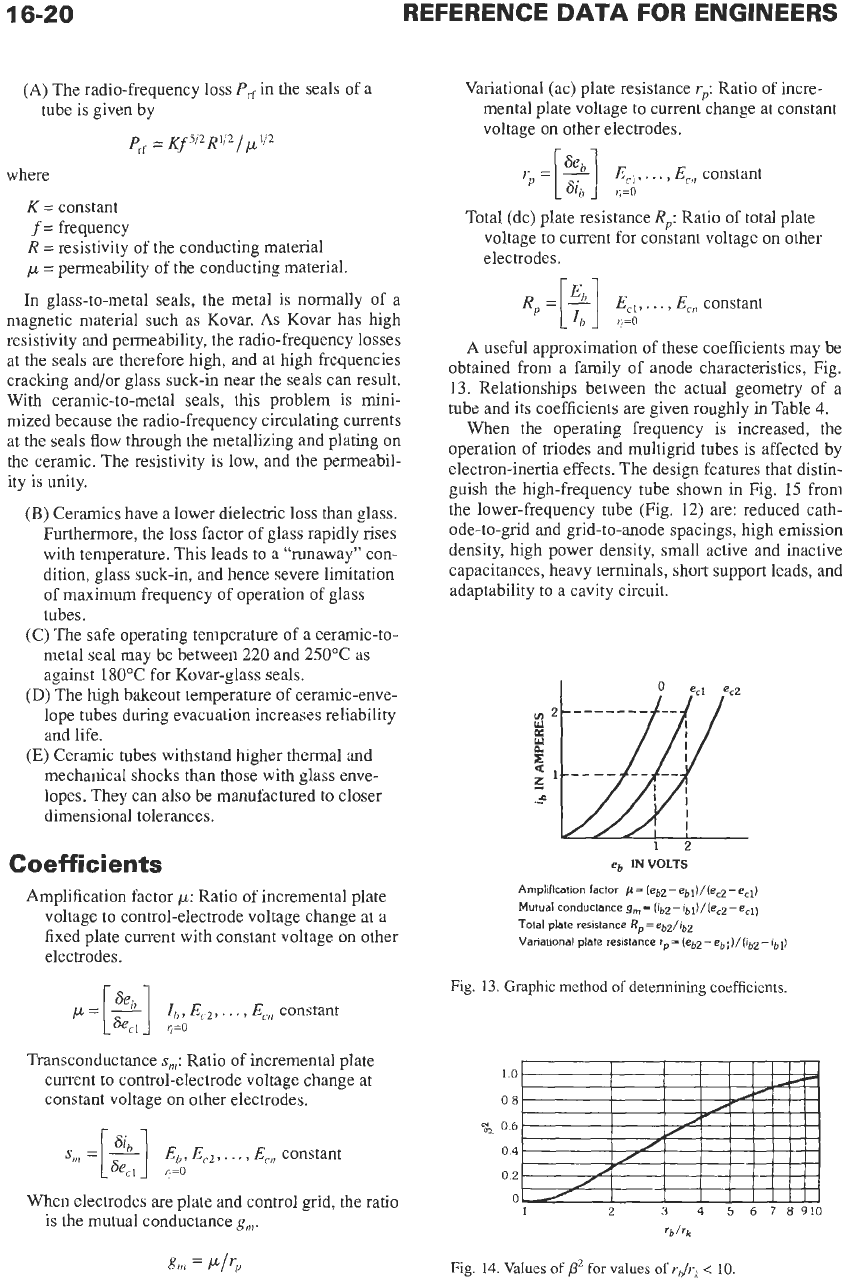
16-20
REFERENCE
DATA
FOR ENGINEERS
(A)
The radio-frequency loss
P,
in the seals of a
tube is given by
p
=
Kf
5/2Rl///p1/2
rf
where
K
=
constant
f
=
frequency
R
=
resistivity of the conducting material
p
=
permeability of the conducting material.
In
glass-to-metal seals, the metal is normally of a
magnetic material such as Kovar. As Kovar has high
resistivity and permeability, the radio-frequency losses
at the seals are therefore high, and at high frequencies
cracking and/or glass suck-in near the seals can result.
With ceramic-to-metal seals, this problem is mini-
mized because the radio-frequency circulating currents
at the seals flow through the metallizing and plating
on
the ceramic. The resistivity is low, and the permeabil-
ity is unity.
(B)
Ceramics have a lower dielectric loss than glass.
Furthermore, the loss factor of glass rapidly rises
with temperature. This leads
to
a “runaway” con-
dition, glass suck-in, and hence severe limitation
of maximum frequency of operation of glass
tubes.
(C) The safe operating temperature of a ceramic-to-
metal seal may be between
220
and
250°C
as
against
180°C
for Kovar-glass seals.
(D)
The high bakeout temperature of ceramic-enve-
lope tubes during evacuation increases reliability
and life.
(E)
Ceramic tubes withstand higher thermal and
mechanical shocks than those with glass enve-
lopes. They can also be manufactured to closer
dimensional tolerances.
Coefficients
Amplification factor
p:
Ratio of incremental plate
voltage to control-electrode voltage change at a
fixed plate current with constant voltage on other
electrodes.
Transconductance
s,:
Ratio of incremental plate
current to control-electrode voltage change at
constant voltage on other electrodes.
--
sm
=
[?J
Ebr
Ecc2,.
.
,
,
E,, constant
,;=O
When electrodes are plate and control grid, the ratio
is the mutual conductance
g,.
gm
=
P
f~p
Variational (ac) plate resistance
rp:
Ratio of incre-
mental plate voltage to current change at constant
voltage
on
other electrodes.
r=b
p
z;?.
.
.
>E,,
constant
Total (dc) plate resistance
Rp:
Ratio of total plate
voltage
to
current for constant voltage
on
other
electrodes.
R
=
-
E,,,
...
,
E,,,
constant
[::I
i,=o
A useful approximation of these coefficients may be
obtained from a family of anode characteristics, Fig.
13.
Relationships between the actual geometry of a
tube and its coefficients are given roughly
in
Table
4.
When the operating frequency is increased, the
operation of triodes and multigrid tubes is affected by
electron-inertia effects. The design features that distin-
guish the high-frequency tube shown in Fig.
15
from
the lower-frequency tube (Fig.
12)
are: reduced cath-
ode-to-grid and grid-to-anode spacings, high emission
density, high power density, small active and inactive
capacitances, heavy terminals, short support leads, and
adaptability to a cavity circuit.
eb
INVOLTS
Amplification factor
p=
(eb2-ebl)/(ec2-e,l)
Mutual conductance
gm=
(ib2-
ibl)/(ec2-ecl)
Total plate resistance
Rp
=
eb2/ib2
Variational plate resistance
rp
=
(eb2
-
ebl)/(ib2
-
ibll
Fig.
13.
Graphic
method of
determining coefficients.
10
08
ma
06
04
02
0
1
2
3
4
5
6
78910
‘bIrk
Fig.
14.
Values
of
pz
for
values
of
rb/rk
<
10.

ELECTRON TUBES
16-21
TABLE
4.
TUBE CHARACTERISTIC§
FOR
UNIPOTENTIAL CATHODE
AND
NEGLIGIBLE SATURATION
OF
CATHODE
Function Parallel-Plane Cathode and Anode Cylindrical Cathode and Anode
G
Diode anode current (amperes)
G1eh3‘*
lb
Triode anode current (amperes)
Diode perveance
Gl
2.3
x
(Add,
’)
2.3
x
los6
(Ab/P2r2)
Triode perveance
G,
2.3
x
10“ (Ab/dbdc)
2.3
x
(Ad@rbrc)
Amplification factor
p
Mutual conductance
g,
l..%zp/(p
+
l)](E’g)
‘I2
1.5G2[p/(p
+
l)l(E’g)
A,
=
effective anode area in square centimeters;
db
=
anode-cathode distance in centimeters;
d,
=
grid-cathode distance in centimeters;
/3
=
geometric constant (a function of the ratio of anode-to-cathode radius),
P
’=
1
for
rb
irk> 10 (Fig. 14);
p
=
pitch
of
grid wires in centimeters; r8
=
grid-wire radius in centimeters;
rb
=
anode
radius in centimeters;
rk=
cathode radius
in
centimeters; r,
=
grid radius in centimeters.
Note:
however, they give a fair idea of the relationship between the tube geometry and the constants of the tube.
G,b+
p
eX1
+
pL)I3”
G&%+
pe,)/(l
+
p)i3”
2.7dc
[(db
/dc)
-
ll/P
lOg(d2mg)l
(237%
/PI
[log(dddc)llog(~/2
mJl
=
+
@c)/(l
+
=
+ pEc)/(I
+
p)
These equations are based
on
theoretical considerations and do not provide accurate results for practical structures;
HEATER
I
CONNECTION
CONNECTION
AIR
COOLING
Fig.
15.
Electrode arrangement of a small high-frequency
external-anode triode.
MATERIALS AND
STRUCTURES
Cathodes
Early cathodes were all directly heated, that is, the
filament, which was heated by passing a current
through it, was also the cathode. The filaments were
made of mostly tungsten
(W)
or thoriated
W
(i.e.,
W
mixed with a small percentage of thoria). Thoriated
W
cathodes are still commonly used in high-power
switch tubes, transmitter tubes, and microwave magne-
trons at operating temperatures of 1600-1900°C.
In a directly heated cathode, the heating current
causes a voltage drop along the current path and across
the surface. Most applications require
indirectly
heated
cathodes
so
that the surface of the cathode is at a con-
stant potential. Oxide-coated cathodes and dispenser-
type cathodes use mostly indirect heaters, with the
heater filament made of
W.
A potted heater, shown in
Fig. 16, uses alumina (A1203) potting material to fill
the space in the cavity that contains the heater, whereas
a nonpotted heater has alumina coating on the surface
of the heater filament only. A potted heater maintains
good thermal contact with the cathode body and pro-
vides uniform heating across the cathode. A nonpotted
heater has a low heat capacity and is suitable for appli-
cations that require fast wm-up. In addition, nonpot-
ted heaters cost much less than potted heaters.
The emitting surfaces
of
oxide-coated cathodes are
initially made
of
Ba, Ca, and Sr carbonates, which
are
converted thermally to respective oxides before elec-
tron emission can occur. The conversion occurs around
800°C and the operating temperabres are 750-800°C.
The emitting surfaces of dispenser-type cathodes are
made
of
pressed tungsten powder impregnated
with
BaO, CaO, and A1,0,. The surfaces of ?-type dis-
penser cathodes are coated with
-5000
A
of
noble
metal, most commonly an
Os/Ru
mixture. The operat-
ing temperatures of dispenser-type cathodes are typi-
cally 900-1250°C.
Grids
Grids are conductors, semitransparent to electrons,
usually in the
form
of meshes or parallel bars. Their
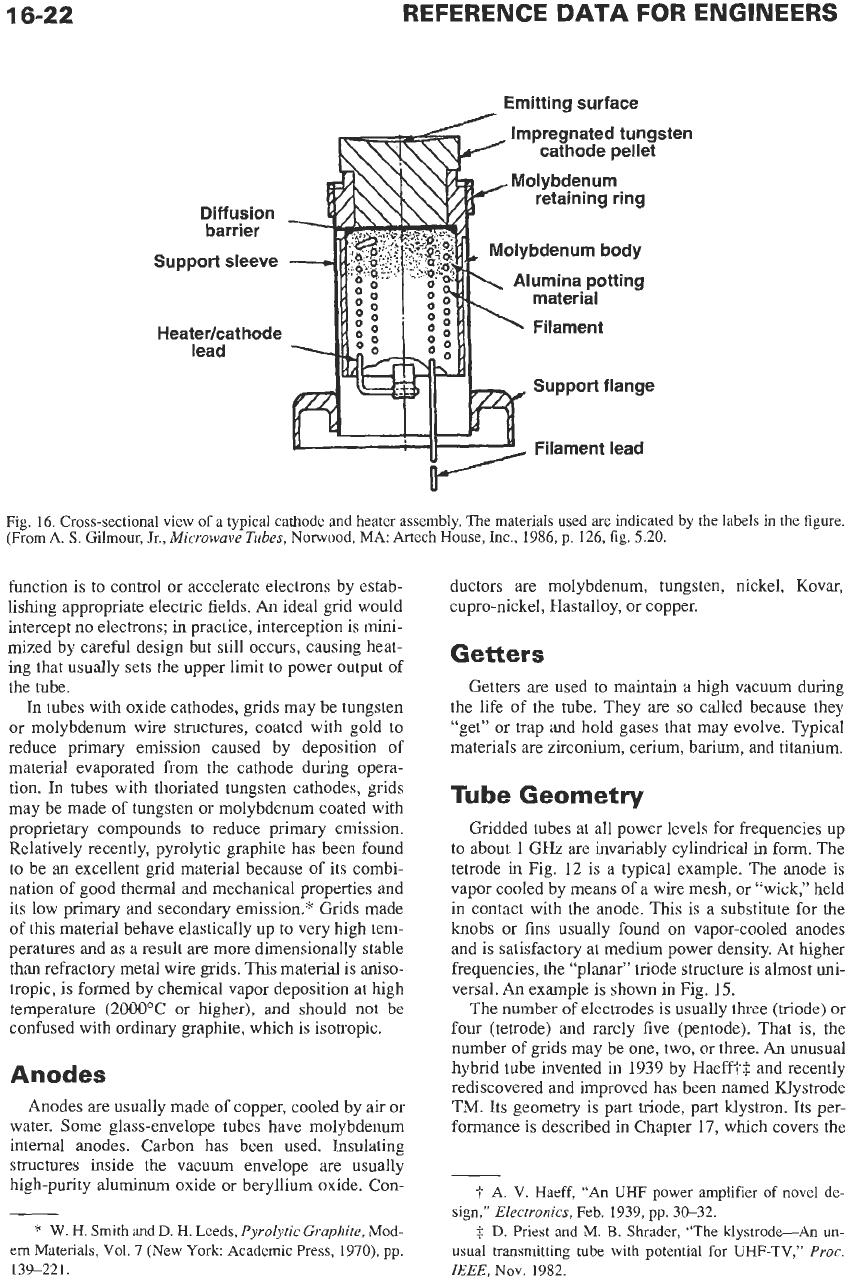
16-22
REFERENCE
DATA
FOR ENGINEERS
Diffusion
barrier
Support sleeve
Heaterlcathode
lead
Emitting surface
-
Impregnated tungsten
cathode pellet
Molybdenum body
Filament lead
Fig. 16. Cross-sectional view
of
a typical cathode and heater assembly.
The
materials used
are
indicated by the labels in the figure.
(From
A.
S.
Gilmour, Jr.,
Microwave
Tubes,
Nonvood, MA: Artech House, Inc., 1986, p. 126, fig. 5.20.
function is
to
control or accelerate electrons by estab-
lishing appropriate electric fields.
An
ideal grid would
intercept
no
electrons;
in
practice, interception is mini-
mized by careful design but still occurs, causing heat-
ing that usually sets the upper limit to power output
of
the tube.
In
tubes with oxide cathodes, grids may be tungsten
or molybdenum wire structures, coated with gold
to
reduce primary emission caused by deposition
of
material evaporated from the cathode during opera-
tion.
In
tubes with thoriated tungsten cathodes, grids
may be made of tungsten or molybdenum coated with
proprietary compounds to reduce primary emission.
Relatively recently, pyrolytic graphite has been found
to be an excellent grid material because
of
its combi-
nation of good thermal and mechanical properties and
its low primary and secondary emission.” Grids made
of this material behave elastically
up
to very high tem-
peratures and as a result are more dimensionally stable
than refi-actory metal wire grids. This material is aniso-
tropic, is formed by chemical vapor deposition at high
temperature
(2000OC
or
higher), and should not
be
confused with ordinary graphite, which is isotropic.
Anodes
Anodes are usually made of copper, cooled by
air
or
water. Some glass-envelope tubes have molybdenum
internal anodes. Carbon has been used. Insulating
structures inside the vacuum envelope are usually
high-purity aluminum oxide or beryllium oxide. Con-
*
W.
H.
Smith and
D.
H. Leeds,
Pyrolytic Graphite,
Mod-
em
Materials, Vol.
7
(New York: Academic
Press,
1970), pp.
139-221.
ductors are molybdenum, tungsten, nickel, Kovar,
cupro-nickel, Hastalloy, or copper.
Getters
Getters
are
used
to
maintain a high vacuum during
the life of the tube. They are
so
called because they
“get”
or
trap and hold gases that may evolve. Typical
materials are zirconium, cerium, barium, and titanium.
Tube Geometry
Gridded tubes at all power levels for frequencies up
to about
1
GHz
are invariably cylindrical in
form.
The
tetrode
in
Fig.
12
is a typical example. The anode is
vapor cooled by means of a wire mesh, or “wick,” held
in contact with the anode. This is a substitute
for
the
knobs or fins usually found
on
vapor-cooled anodes
and is satisfactory at medium power density. At higher
frequencies, the “planar” triode structure is almost uni-
versal.
An
example is shown in Fig.
15.
The number
of
electrodes is
usually
three
(triode)
or
four (tetrode) and rarely five (pentode). That is, the
number of grids may be one, two, or three.
An
unusual
hybrid tube invented in
1939
by Haeffl-3 and recently
rediscovered and improved has been named Klystrode
TM.
Its
geometry is part triode, part klystron.
Its
per-
formance is described
in
Chapter
17,
which covers the
7
A.
V.
Haeff, “An
UHF
power amplifier of novel de-
sign,”
Electronics,
Feb. 1939, pp. 30-32.
$
D.
Priest
and M.
E.
Shrader, “The klystrode-An
un-
usual transmitting tube with potential for UHF-TV,”
Proc.
ZEEE,
Nov.
1982.
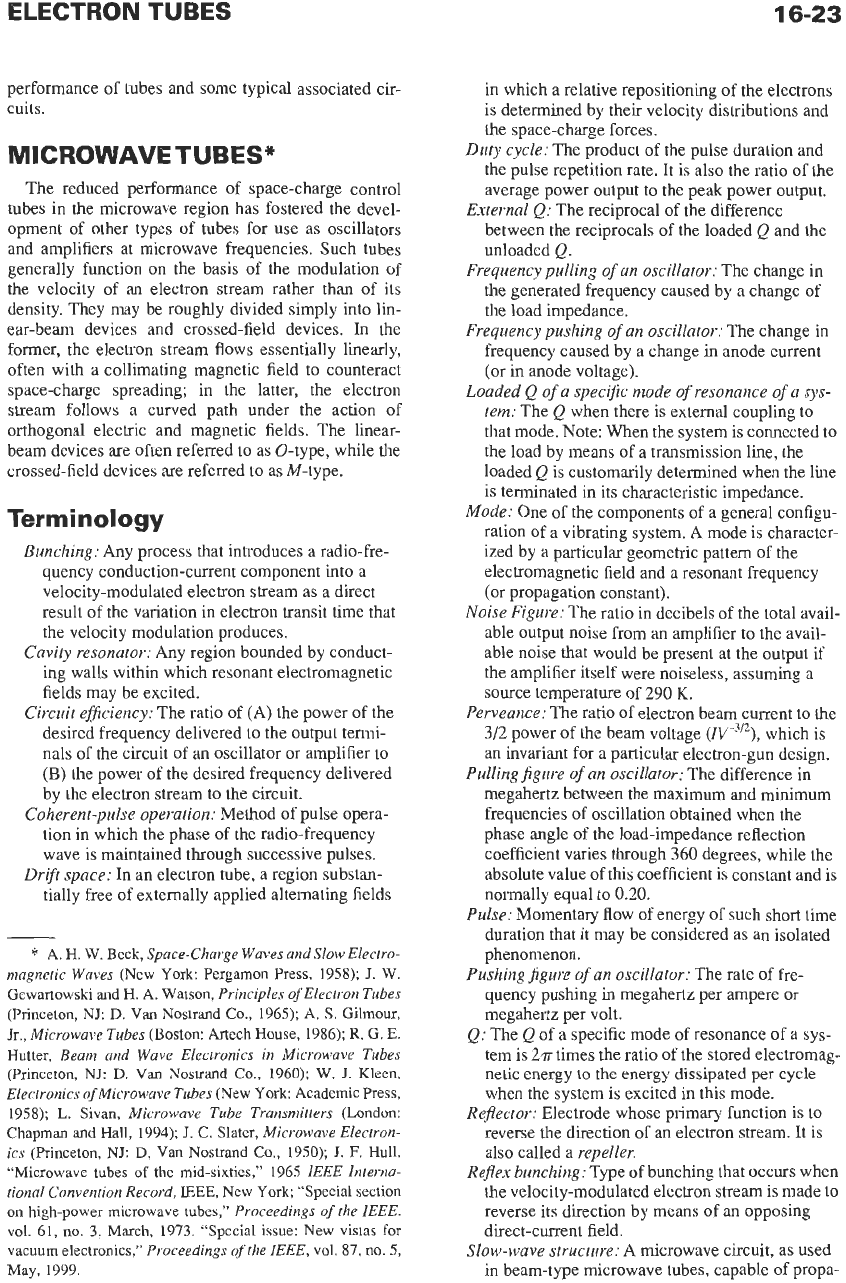
ELECTRON TUBES
16-23
performance of tubes and some typical associated cir-
cuits.
MICROWAVETUBES”
The reduced performance of space-charge control
tubes in the microwave region has fostered
the
devel-
opment of other types of tubes for use as oscillators
and amplifiers at microwave frequencies. Such tubes
generally function on the basis of the modulation of
the velocity of an electron stream rather than of its
density. They may be roughly divided simply into lin-
ear-beam devices and crossed-field devices. In the
former,
the
electron stream flows essentially linearly,
often with a collimating magnetic field to counteract
space-charge spreading; in the latter, the electron
stream follows a curved path under the action of
orthogonal electric and magnetic fields. The linear-
beam devices are often referred to as 0-type, while the
crossed-field devices
are
referred to as M-type.
Terminology
Bunching:
Any process that introduces a radio-fre-
quency conduction-current component into a
velocity-modulated electron stream as a direct
result of the variation in electron transit time that
the velocity modulation produces.
Cavity resonator:
Any region bounded by conduct-
ing walls within which resonant electromagnetic
fields may be excited.
Circuit eflciency:
The ratio of
(A)
the power of the
desired frequency delivered
to
the output termi-
nals of the circuit
of
an oscillator or amplifier to
(B)
the power of
the
desired frequency delivered
by the electron stream to the circuit.
Coherent-pulse operation:
Method of pulse opera-
tion in which the phase of the radio-frequency
wave
is
maintained through successive pulses.
tially free of externally applied alternating fields
Drift space:
In an electron tube, a region substan-
*
A.
H.
W.
Beck,
Space-Charge Waves and Slow Electro-
magnetic Waves
(New York Pergamon Press, 1958);
J.
W.
Gewartowski and
H.
A. Watson,
Principles
of
Electron Tubes
(Princeton,
NJ:
D.
Van Nostrand Co., 1965);
A.
S.
Gilmour,
Jr.,
Microwave Tubes
(Boston:
Artech
House,
1986);
R.
G.
E.
Hutter,
Beam and Wave Electronics
in
Microwave Tubes
(Princeton,
NJ:
D.
Van
Nostrand
Co.,
1960);
W.
J.
Kleen,
Electronics
of
Microwave Tubes
(New York: Academic Press,
1958);
L.
Sivan,
Microwave Tube Transmitters
(London:
Chapman and Hall, 1994);
J.
C. Slater,
Microwave Electron-
ics
(Princeton,
NJ
D,
Van Nostrand Co., 1950);
J.
F.
Hull,
“Microwave tubes
of
the mid-sixties,” 1965
IEEE Interna-
tional Convention Record,
IEEE,
New York; “Special section
on high-power microwave tubes,’’
Proceedings
of
the IEEE,
vol. 61, no. 3, March, 1973. “Special
issue:
New vistas
for
vacuum electronics,”
Proceedings
of
the IEEE,
vol. 87,
no.
5,
May, 1999.
in which a relative repositioning of the electrons
is determined by their velocity distributions and
the space-charge forces.
Duty cycle:
The product of the pulse duration and
the pulse repetition rate.
It
is also the ratio of the
average power output to the peak power output.
between the reciprocals of the loaded
Q
and the
unloaded
Q.
Frequency pulling of an oscillator:
The change in
the generated frequency caused by a change of
the load impedance.
Frequency pushing of an oscillator:
The change in
frequency caused by a change in anode current
(or
in anode voltage).
Loaded
Q
ofa spec$c mode of resonance of a sys-
tem:
The
Q
when there is external coupling to
that mode. Note: When the system is connected to
the load by means of a transmission line, the
loaded
Q
is customarily determined when the line
is terminated in its characteristic impedance.
Mode:
One of the components of a general configu-
ration
of
a vibrating system.
A
mode is character-
ized by a particular geometric pattern of the
electromagnetic field and a resonant frequency
(or propagation constant).
Noise Figure:
The ratio in decibels of the total avail-
able output noise from an amplifier to the avail-
able noise that would be present at the output if
the amplifier itself were noiseless, assuming a
source temperature of
290
K.
Perveance:
The ratio of electron beam current to the
312
power of
the
beam voltage
(W3’’),
which is
an
invariant for a particular electron-gun design.
Pullingfigure
of
an oscillator:
The difference in
megahertz between the maximum and minimum
frequencies of oscillation obtained when the
phase angle of the load-impedance reflection
coefficient varies through
360
degrees, while the
absolute value of this coefficient
is
constant and is
normally equal to
0.20.
Pulse:
Momentary flow of energy of such short time
duration that it may be considered as
an
isolated
phenomenon.
Pushingfigure of an oscillator:
The rate
of
fre-
quency pushing in megahertz per ampere or
megahertz per volt.
Q:
The
Q
of a specific mode of resonance of a sys-
tem is
2.rr
times the ratio of the stored electromag-
netic energy to the energy dissipated per
cycle
when the system is excited in this mode.
Reflector:
Electrode whose primary function is
to
reverse the direction of an electron stream. It is
also called a
repeller.
Reflex bunching:
Type of bunching that occurs when
the velocity-modulated electron stream is made
to
reverse its direction by means of
an
opposing
direct-current field.
Slow-wave structure:
A
microwave circuit, as used
in beam-type microwave tubes, capable of propa-
External
Q:
The reciprocal of
the
difference

REFERENCE
DATA
FOR
ENGINEERS
gating radio-frequency waves with phase veloci-
ties appreciably less than the velocity of light.
Recent
Trends
Dramatic progress in device performance and capa-
bility has been achieved in the 1980s and 1990s. These
advances can be credited
to
a
combination of device
innovation, enhanced understanding gained through
improved modeling and design, introduction of supe-
rior materials and subassembly components, and
development of advanced vacuum processing and con-
struction techniques. The most familiar types of micro-
wave power tube, invented in the decade spanning the
mid-1930s and 1940s, may be broadly classified
as
“slow-wave’’ devices. This description
as
being slow-
wave emphasizes the fundamental requirement in
these devices that the phase velocity of the electromag-
netic wave on the interaction circuit must be approxi-
mately equal to the velocity of the electron stream if
energy transfer between the beam and the wave is to
occur. The electron velocity is less than the speed of
light and hence the wave phase velocity must also be
slower than the speed of light in free space. From the
richness of device concepts investigated through the
1960s, the helix and coupled cavity traveling-wave
tubes (TWTs), the klystron, magnetron, and crossed
field amplifier (CFA) have emerged
as
the primary
products
of
today’s technology. The continuing vitality
of this relatively mature segment of the technology is
demonstrated by the recent development of
a
hybrid
amplifier architecture, the microwave power module
(MPM), that combines the best features of solid-state
and vacuum technologies. This hybrid approach yields
a
cost-competitive amplifier that offers the power, effi-
ciency, and bandwidth of
a
TWT with the reduced
noise and functionality of a solid-state amplifier with
either discrete
or
monolithic components. Most signif-
icantly, this performance is obtained in
a
miniaturized
package that can be
a
small fraction of the size of a
comparable TWT amplifier (TWTA) or an
all
solid-
state power amplifier (SSPA).
The most dramatic of the modem trends, however,
is the extension of device operation into the spectral
range well beyond the microwave. Beginning in the
mid-l960s, two new classes
of
powerful “fast-wave’’
device,
the
gyro-oscillator/amplifier
and the free
electron laser (FEL), have experienced ongoing
development. In fast-wave devices, the phase velocity
of the electromagnetic wave exceeds the speed of
light in the interaction region. Although the physical
interaction mechanism is not the same, gyro-devices
are technologically very similar to other microwave
power tubes. They differ primarily by their intrinsic
need for magnetic field strengths typically available
only from superconducting magnets. In recent years,
gyro-oscillators have produced output powers
approaching
a
megawatt in the frequency range of
100-200
GHz
with the pulse duration nearing
a
sec-
ond.
In
the guise of the ubitron, free electron masers
are much akin to their slow-wave cousins. By using
electrons at relativistic energies, the operational
domain of the FEL is extended to much shorter wave-
length. For this extension,
a
high-energy electron
accelerator replaces the electron gun and optical cav-
ities replace the interaction circuits of the microwave
power tube. Free electron lasers are now generating
usable levels of tunable power
at
submillimeter wave-
lengths and in the infrared and promise to provide
high-power, continuously tunable coherent sources
over
a
spectral range extending into the ultraviolet
and eventually
to
x rays.
For very general comparison of device limits, the
average power density,
Pavf2,
in units
of
(MW)(GHz)’,
has been used
as
a
figure of merit providing an insight-
ful
basis
for comparing device types and portraying
growth trends in performance. The physical signifi-
cance of
Pa,f2
as
a
figure of merit derives from the fact
that the maximum beam or charge-carrier power that
can be transported through
a
device is proportional
to
the circuit cross-sectional area, which
is
inversely
pro-
portional
to
the operating frequency. Upper limits
in
“power density” were therefore considered
as
intrinsic
to a device design. With this in mind, the progression
of power density for major device types is plotted in
Fig. 17. In general, the power density profile for each
device type exhibits the characteristic S-shaped curve
associated with technological maturity. The slow
progress typical of
a
period of innovation and prelimi-
nary study is followed by the rapid growth associated
with intense development.
As
the fundamental limits
of
a
particular device are approached, progress
becomes more difficult and the curve flattens. Escape
from the limits imposed by
a
particular device concept
requires finding
a
better approach. Following this argu-
ment, we conclude that the vitality of a technology is
measured by its ability
to
provide research opportuni-
ties leading to the next step.
As
seen by the sustained growth in achieved power
density, RF vacuum electronics continue to provide
such opportunity. The history of RF vacuum electron-
ics can be viewed as successive waves of scientific
innovation driven by technical opportunity coupled
with market demand.
First,
the gridded tube is over-
taken by the magnetron under the impetus of wartime
demands. Then, the high-power linear-beam
tubes,
the
klystron and the coupled cavity
TWT,
move to the fore
in response to accelerator and radar interests. Finally,
the gyro-oscillator and the
FEL
surpass
slow-wave
devices in the mid-1970s. With these transitions, the
envelope of vacuum device performance, as defined by
the straight line in Fig. 17, continues to grow exponen-
tially at
an
approximate rate of one-and-a-half orders
of magnitude per decade,
a
rate sustained for the past
60
years.
In
contrast to the fast-wave devices, the
fig-
ures
of
merit for the slow-wave devices have grown
very little since the mid-1960s.
One significant exception to limited growth with
slow-wave devices is the
periodic-permanent-magnet-
(PPM-) focused helix
TWT,
whose pace of growth
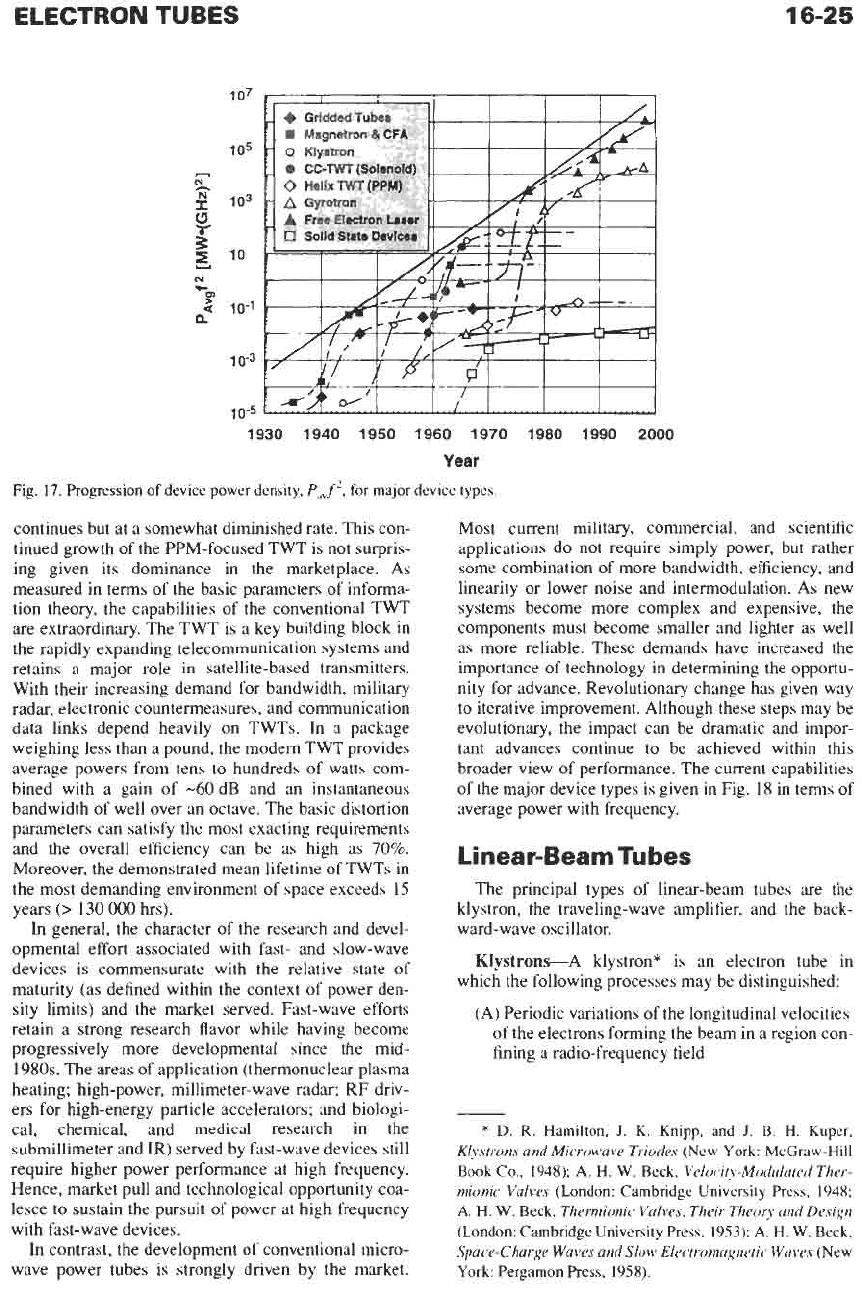
5
I
u
Y
3
3
N
r
D
4
n
107
1
05
103
10
lo-’
10-3
10-5
1930
I940
1950 1960 1970 1980 1990
2000
Year
Fig.
17.
Progrrssion
of
device power density,
P,f2,
for
major
device
types.
continues but at a somewhat diminished rate. This con-
tinued
growth
of the PPM-focused
TWT
is not
surpris-
ing given its dominance in the marketplace. As
measured in terms of the basic parameters of informa-
tion theory, the capabilities of the conventional
TWT
are
extraordinary. The
TWT
is a key building block in
the rapidly expanding telecommunication systems and
retains a major role in satellite-based transmitters.
With their increasing demand for bandwidth, military
radar, electronic countermeasures, and communication
data links depend heavily on
TWTs.
In a package
weighing less than a pound, the modem
TWT
provides
average powers from tens to hundreds of watts com-
bined with a gain of -60dB and an instantaneous
bandwidth of well over an octave. The basic distortion
parameters can satisfy the most exacting requirements
and the overall efficiency can be as high as
70%.
Moreover, the demonstrated mean lifetime of
TWTs
in
the most demanding environment of space exceeds
15
years
(>
130
OOO
hrs).
In
general, the character of the research and devel-
opmental effort associated with fast- and slow-wave
devices is commensurate with the relative state of
maturity
(as
defined within the context of power den-
sity limits) and the market served. Fast-wave efforts
retain a strong research flavor while having become
progressively more developmental since the mid-
1980s.
The
areas
of application (thermonuclear plasma
heating; high-power, millimeter-wave radar;
RF
driv-
ers
for high-energy particle accelerators; and biologi-
cal, chemical, and medical research in the
submillimeter and
IR)
served by fast-wave devices still
require higher power performance at high frequency.
Hence, market pull and technological opportunity coa-
lesce to sustain the pursuit
of
power at high frequency
with fast-wave devices.
In contrast, the development of conventional micro-
wave power tubes is strongly driven by the market.
Most current
military,
commercial, and scientific
applications do not require simply power, but rather
some combination of more bandwidth, efficiency, and
linearity or lower noise and intermodulation. As new
systems become more complex and expensive, the
components must become smaller and lighter as well
as more reliable. These demands have increased the
importance of technology in determining the opportu-
nity for advance. Revolutionary change has given way
to iterative improvement. Although these steps may be
evolutionary, the impact can be dramatic and impor-
tant advances continue to
be
achieved within
this
broader view of performance. The current capabilities
of the major device types is given in Fig. 18 in terms of
average power with frequency.
Linear-BeamTubes
The principal
types
of linear-beam tubes are the
klystron, the traveling-wave amplifier, and the back-
ward-wave oscillator.
Klystrons-A klystron* is an electron tube in
(A) Periodic variations of the longitudinal velocities
of the electrons forming the beam in a region con-
fining a radio-frequency field
which the following processes may be distinguished:
*
D.
R.
Hamilton,
I.
K.
Knipp, and
J.
B. H.
Kuper,
Klystrons and Microwave Triodes
(New York: McGraw-Hill
Book Co., 1948);
A.
H.
W.
Beck,
Velocity-Modulated Ther-
mionic Valves
(London: Cambridge University
Press,
1948;
A.
H.
W.
Beck,
Thermionic Valves, Their Theory and Design
(London: Cambridge University
Press,
1953);
A.
H.
W.
Beck,
Space-Charge Waves and Slow Electromagnetic Waves
(New
Yo& Pergamon
F’ress,
1958).
